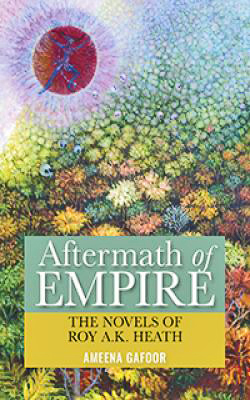September 5, 2018 issue
Authors' & Writers' Corner

Kamil Ali
Thirteen-year-old Jimmy had to make significant adjustments on his first day with his new foster parents, Moe and Mille Cheevers, who worked at night and spent the day sleeping with shades over the windows to block out the sunlight.
He retired for the night with a book from his favorite detective series before falling asleep. Loud squeaking in the attic woke him up at midnight.
When evening arrived, and the bats exited to search for food, Jimmy pulled himself up into the attic with the flashlight. He tiptoed in the bat dung to inspect the items. A strange looking keyboard caught his attention. He sneaked it to his room and hid it under his bed for a closer examination after the Cheevers left for work.
When he researched the strange contraption on the internet, he learned that it was called a ‘typewriter.’ Several videos demonstrated its operation. He followed the instructions to load a blank sheet of paper on a rolling cylinder.
When he punched any letter on the keyboard an arm with two raised versions of the same letter on its head impacted the paper and left the letter’s impression on it. He used the shift key to lift the cylinder for the upper case of the letters to strike it.
“It uses a ribbon with ink to mark the letters on the paper.” The video maker identified two spindles. “The ribbon rolls off one spindle and onto the other.”
The cradle holding the cylinder moved to the left with each letter typed. At the end of each line of writing, the instructor used a lever to move the cradle back to the beginning position. The lever rolled the cylinder at the same time to start the next line.
Upon arrival at home the next day, he completed his homework early and read his novel until the Cheevers left for work. He wanted to write his own story but had to punch the keys hard enough to imprint the letters on the paper without the ink-ribbon.
After pondering on an opening line for his story, he gave up and shoved the device under the bed.
He dreamt that he heard the click under the bed at the same time as the squeaks in the attic at midnight. At sunrise, he pulled out the typewriter and found the word, ‘Hi,’ written on it in red ink. He had not dreamt it! He punched the same word in response and shoved the machine back under the bed.
During the day, he searched for stores selling typewriter ribbon but found none. A last check of the typewriter before bed revealed nothing new.
The squeaks above and clicks beneath his bed pulled him out of sleep. With his heart pumping, he lifted a corner of the pillow and peered into the darkness. His phone showed midnight.
Unable to go back to sleep, Jimmy lay wide awake until morning. He pulled out the typewriter and read the bold red words, ‘GET OUT!’ Jimmy typed, ‘WHY?’, and pushed the typewriter back under the bed before leaving for school.
After homework that evening, he stayed awake in bed. At the stroke of midnight, the squeaking and clicking lasted a few seconds and stopped.
Jimmy leaned over the edge of the bed and read upside down, ‘THEY WILL KILL YOU LIKE THEY KILLED US.’ The words sent a chill down his spine.
Jimmy glanced at his phone and hopped off the bed to switch on the light. He had to type quickly before the hour passed. When he typed, ‘WHO ARE YOU?’, the typewriter’s keys pressed themselves, to write, ‘THEY ARE VAMPIRES WHO KIDNAPPED US AS STREET KIDS AND DRANK OUR BLOOD. THEY HAVE HIDDEN THE TYPEWRITER’S RIBBON IN THEIR LOCKED ROOM.’
‘DO THEY REALLY WORK AT NIGHT?’ Jimmy jumped at every sound as he typed.
The typewriter clicked again, ‘THEY ROAM THE STREETS
LOOKING FOR VICTIMS TO FEAST ON.’
‘WHY ME?’ Jimmy needed to know.
‘THEY WILL KEEP YOU AS AN EMERGENCY FOOD SOURCE. YOU MUST KILL THEM BEFORE THEY KILL YOU. YOU ARE OUR ONLY HOPE TO FREE US FROM THIS MACHINE. IF YOU DIE, YOUR SOUL WILL BE TRAPPED WITH US IN THIS TYPEWRITER LIKE OURS.’
Bolts on the outside of the doors and windows nailed shut prevented escape. None of the telephones worked. He locked himself in the downstairs bathroom and pulled out his cell phone, but the battery had no current.
After listening for sounds of movement in the house, he dashed up to his room and pulled the sheet and cover off his bed. He rolled them into ropes and tied both front and back door handles to immovable objects to keep them shut.
He grabbed his phone charger from the bedroom and returned to the bathroom, where he plugged in the phone to charge.
Just before dawn, he heard their struggles to enter the home. Jimmy called the police with the little charge he had on his phone.
When the police knocked, Jimmy opened the front door to let them in. They asked about the two piles of ashes outside the front door. He shrugged and told them that he had barricaded himself against noises outside the house that sounded like a break-in.
After the police left, he checked the paper on the typewriter. He read, ‘THANK YOU!’ A peek in the attic showed dozens of clumped ashes on the bat feces.
The disappearance of the Cheevers automatically put ownership of the house in Jimmy’s name.
He buried the typewriter in the backyard.
devotion to Heath

Ameena Gafoor, Aftermath of Empire: The Novels of Roy A. K. Heath, UWI Press, Mona, Jamaica, 2018.
A review by Frank Birbalsingh
Roy Heath’s oeuvre of nine novels proclaim him as one of the finest Anglophone Caribbean novelists, and certainly one of the best from Guyana, so it is something of a surprise that Ameena Gafoor’s Aftermath of Empire: The Novels of Roy A.K. Heath is, so far, the only comprehensive critique of the author’s fiction: it probably speaks to the originality of Gafoor’s critical acumen as well as her patriotic devotion to the future of Guyanese letters. Born in Guyana (formerly British Guiana) Roy Heath (1926 -2008) migrated in 1950 to London, England, where, but for periodic visits to Guyana, he remained for the rest of his life. He studied languages at the University of London, and worked throughout his career as a school teacher of French and German; he also qualified as a lawyer but never practised law. His novels are all based on life in Guyana’s capital city of Georgetown from the 1920s to the decade or two immediately after World War Two, when Britain’s Caribbean colonies, including Guyana gained independence from Britain.
Heath’s first novel A Man Come Home was published in 1979 while his ninth The Ministry of Hope, a brilliant satire on Burnham’s riotous regime as President, appeared in 1997. Three novels From the Heat of the Day (1979) One Generation (1981) and Genetha (1981), known collectively as the Armstrong trilogy, are next followed by Kwaku or the Man who Could not Keep his Mouth Shut, (1982) Orealla (1984) and The Shadow Bride (1988), while two further novels A Man Come Home (1979) and The Shadow Bride (1988) complete Heath’s oeuvre, except for his second novel The Murderer (1978) which we may take as his best work if its capture of the 1978 fiction prize offered by the British newspaper The Guardian is anything to go by. In addition, Shadows Round the Moon ((1990), Heath’s autobiography, is nothing less than a masterpiece of lyrical evocation.
In “A Portrait of an Artist” Chapter One of her book, Gafoor briefly surveys Heath’s biography while acknowledging the contribution of earlier Guyanese novelists such as Edgar Mittelholzer, Wilson Harris and Jan Carew, or poets like A.J. Seymour and Martin Carter to Guyanese literature. Chapter Two of The Aftermath of Empire then fills in essential information about Heath’s Armstrong trilogy and the social and cultural history of Guyana as a former British Caribbean colony dominated by ethics based on race, colour and class. After a history of African slavery and Indian indenture, by the twentieth century, a majority of the Guyanese population consisted of Indians descended from indentured labourers, a slightly smaller group of Africans descended from slaves, and much smaller groups of European Whites, Chinese, Amerindians, and Portuguese who are not considered as white because of their indenture background. But Heath’s fiction focuses on yet another small group of mixed African and White ethnicity who, like himself, are known as “coloured.”
After inevitable ethnic and cultural mixing during colonialism an important issue arises about the notion of family in Guyana. As Gafoor writes: “The [coloured] Armstrong family is about the Armstrong family, but there is no family, and all evidence points to the illogic of its unity.” Neither is there any settled sense of community as we see from the title of Chapter Three “From the Heat of the Day: In Search of Community.” Independence brought little change to deep-seated psychological and cultural problems that stifled the natural growth of family, community or nationhood: Guyanese society was too intricately compromised by centuries of ethnic mixing and colonial rule, as suggested by Guyanese historian Elsa Goveia who claims that colonialism had imposed: “a stable and predictable order” on Guyana, but dismantling that order: “left the individual and the society in a void, trapped in postures and mental attitudes that indicate a malignant and crippling interiorization of the old order.”
In an opening paragraph of A Man Come Home, Egbert Foster a fifty-year-old artisan living in a modest cottage slightly better than the tenements and range yards of fellow workers, is ironically depicted raising the new Guyana flag on Independence day, 26th May, 1966, with his dog “sitting under the flag and scratching itself languidly.” As Gafoor writes, one character in A Man Come Home leaves school at the age of twelve: “to deliver bread on a carrier bicycle” and another “to devote his time to a life of sloth” and as they grow older “gravitate to the vicarious pleasure of rum and sex [and] the fantasy of tall tales of bravado and boasting of imaginary travels to foreign lands.” Gafoor further writes: “Foster is an emasculated colonial whose aspirations are undercut by his own deformed will.” Social confusion and struggle over poverty create loss of community, and trickster figures like Fingers who are “metaphors of the degradation endemic in post-colonial societies.”
Most of all though, it is in The Murderer where Galton Flood is overcome by psychosis to murder his wife Gemma and throw her body in the Demerara river that we see the most deadly effect of the failure of freed Guyanese to transcend malign, psychological effects of decolonization. The influence of Galton’s fundamentalist Christian upbringing and the domineering influence of his mother are crippling, and as Gafoor once again argues, he struggles for new freedom and identity in a society “whose collective psychic failure is rooted in the conventional morality of the mother country.” In Gafoor’s view, novels like A Man Come Home and The Murderer question the existential possibilities of people mired in centuries of crippling cliched relationships that have misshaped the psyche, [and Galton comes to] a grim interpretation of society that argues that the colonial order is deeply embedded and necessitates brutal solutions before independence can acquire meaning and offer viable paradigms of selfhood.” Murder may not be a brutal enough solution to postcolonial problems in The Murderer but it illustrates the postcolonial dilemma of Guyanese.